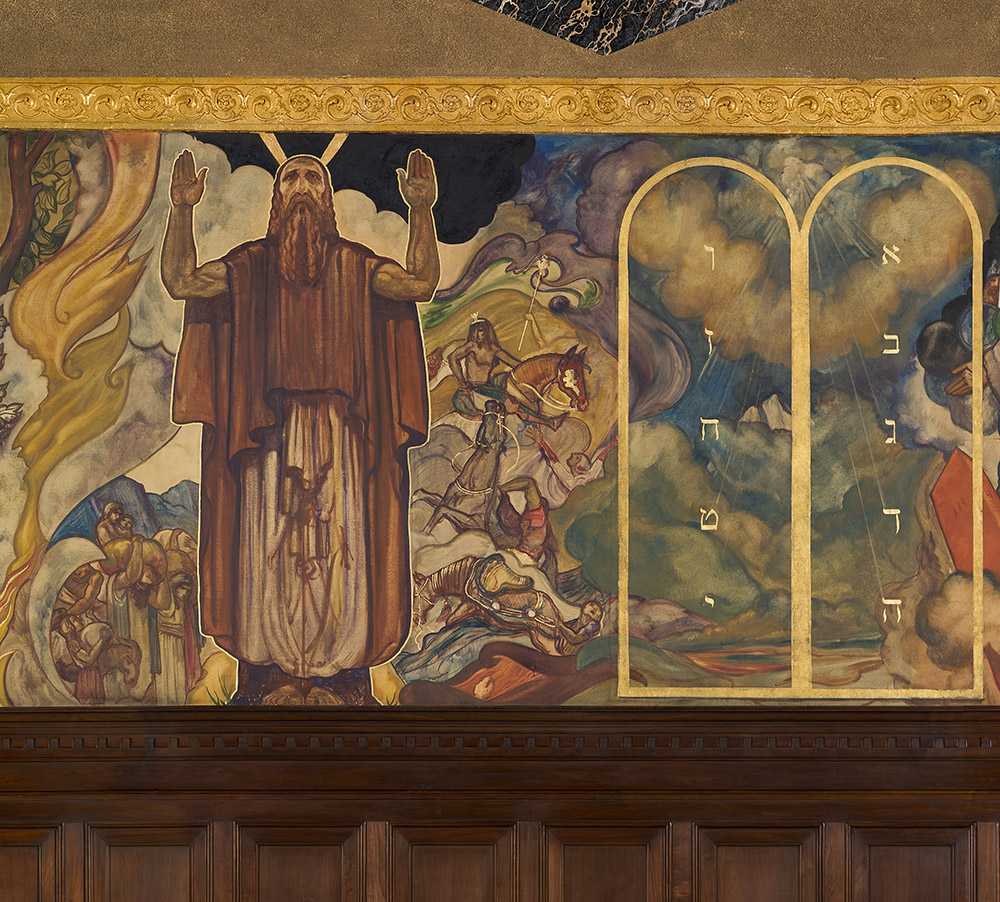Wilshire Boulevard Temple - Moses

- In Magnin's Words
- Cinematic Influences
- Source/Citations
Rabbi Edgar F. Magnin described Ballin's murals in a book published in 1974:
"The figure Moses is one of great dignity. His arms reach heavenward as a symbol of hop and prayer. Rays of light emanate from his head. In back of him are clouds. On the left below him are the Hebrews who crossed the Red Sea in safety; on the right are Egyptian horses, chariots and their riders being hurled into the mighty waters.
Next we see the Decalogue or the foundation stone of our moral civilization. Peering through them one beholds Mt. Sinai, its summit surrounded by clouds and lightening playing about it. The letters on the tablets represent commandments."
"The figure Moses is one of great dignity. His arms reach heavenward as a symbol of hop and prayer. Rays of light emanate from his head. In back of him are clouds. On the left below him are the Hebrews who crossed the Red Sea in safety; on the right are Egyptian horses, chariots and their riders being hurled into the mighty waters.
Next we see the Decalogue or the foundation stone of our moral civilization. Peering through them one beholds Mt. Sinai, its summit surrounded by clouds and lightening playing about it. The letters on the tablets represent commandments."
In her study of the murals at Wilshire Boulevard Temple, art historian MacKenzie Stevens identified this portion of the frieze as the clearest example of the influence of film on Ballin's work. According to Stevens, Ballin had worked as a consultant on Cecil B. deMille's epic 1923 film "The Ten Commandments" staring Theodore Roberts as Moses and Charles de Roche as the pharaoh Rameses. Although most of DeMille's film focuses on an allegorical story of two brothers set in modern times, the first third of the film depicts the Moses story and includes an image strikingly similar to Ballin's representation here. Stevens identifies two motifs in particular: the figure of Moses (who, in the film, stands in a similar position, holding his hands raised towards God with heavenly beams of light projecting from him) and the Decalogue (tablets onto which the commandments were written), which appear in a similar outline form with clouds and lighting surrounding it. Stevens postulates that Ballin may have drawn on motifs from the film both because of his work on the film, and because they provided a familiar and recognizable visual language through which to communicate his ideas. Historian Merry Ovnick has made a similar argument about the influence of silent film on architecture in 1920s Los Angeles, arguing that silent films, "not only inspired style replication but also gave rise to a new language of form based on visual awareness guided by cinematic conventions." 1
Caption from Rabbi Edgar F. Magnin's book, The Warner Murals in the Wilshire Boulevard Temple, Los Angeles, California, published by the Wilshire Boulevard Temple, 1974.
1. Mackenzie Stevens' findings were related in a lecture entitled “Visualizing Jewish History for a Modern Audience" presented to the Los Angeles Metro Studies Group in May, 2013. She is a graduate student at the University of Southern California.
Quotation from Merry Ovnick, "'The Mark of Zorro': Silent Film's Impact on 1920s Architecture in Los Angeles," California History, vol. 86 no. 1 (2008): 29.
| Previous page on path | Wilshire Boulevard Temple - Gallery, page 2 of 12 | Next page on path |

Discussion of "Wilshire Boulevard Temple - Moses"
Add your voice to this discussion.
Checking your signed in status ...